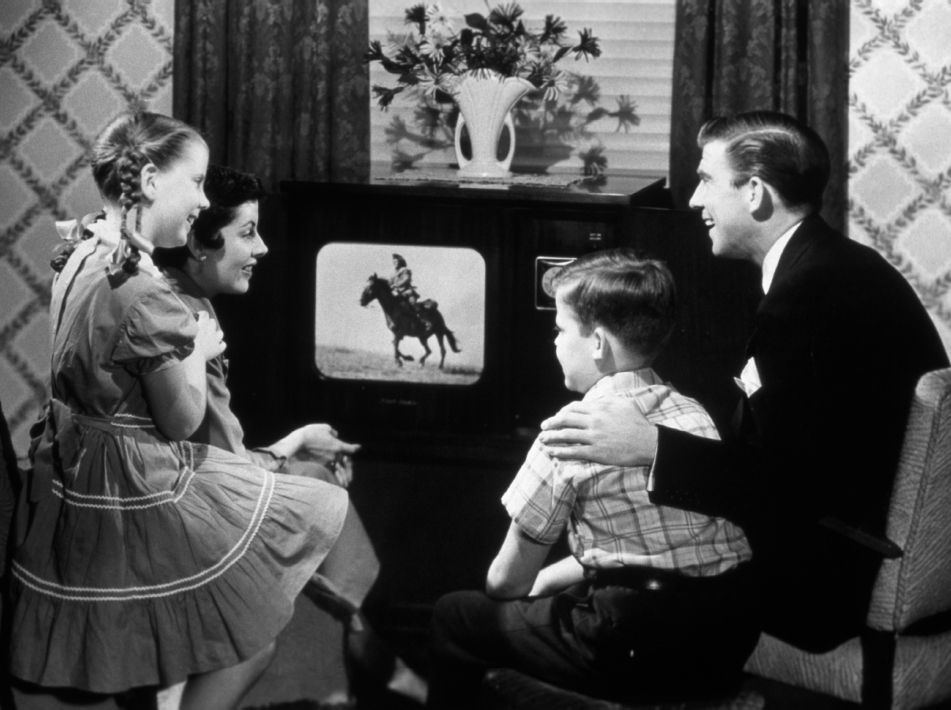Exploring American Histories: Printed Page 795
Exploring American Histories, Value Edition: Printed Page 650
The Rise of Television
Few postwar developments had a greater impact on American society and politics than the advent of television. The first commercial TV broadcast occurred in 1939, but television sets did not become widely available until after World War II. The three major television networks—the Columbia Broadcasting System (CBS), the National Broadcasting Company (NBC), and the American Broadcasting Company (ABC)—offered programs nationwide that appealed to mainstream tastes while occasionally challenging the public with serious drama, music, and documentaries. During the 1950s, congressional investigations became a staple of television, and none provided a better morality tale than coverage of the army-McCarthy hearings in 1954 (see chapter 24). In the same manner, television networks began to feature intense presidential campaign coverage, from the national nominating conventions to election day vote tallies, and political advertisements began to fill the airwaves.

If many Americans recall the 1950s as a time of innocence, they have in mind television shows aimed at children, such as Howdy Doody, Superman, Hopalong Cassidy, The Cisco Kid, and The Lone Ranger. In the course of a half hour, the casts performed in shows that pitted good versus evil and in which honesty and decency triumphed. These youth-oriented television programs showcased a simple world of moral absolutes.
In similar fashion, adults enjoyed evening television shows that depicted old-fashioned families entertaining themselves, mediating quarrels sensibly and peacefully, and relying on the wisdom of parents. In The Adventures of Ozzie and Harriet, the Nelsons raised two clean-cut sons. In Father Knows Best, the Andersons—a father and mother and their three children—lived a tranquil life in the suburbs, and the father solved whatever dilemmas arose. The same held true for the Cleaver family on Leave It to Beaver. In I Love Lucy, the show’s namesake, played by Lucille Ball, and her female sidekick tried to outwit their husbands on a weekly basis. Despite the focus on the women and the sympathy they engendered, men usually won this battle of the sexes. Television portrayed working-class families in grittier fashion on shows such as The Life of Riley, whose lead character worked at a factory, and The Honeymooners, whose male protagonists were a bus driver and a sewer worker. Nevertheless, like their middle-class counterparts, these families stayed together and worked out their problems despite their more challenging financial circumstances.
By contrast, African American families received little attention on television. Black female actors usually appeared as maids, and the one show that featured an all-black cast, The Amos ’n’ Andy Show, generally portrayed African Americans according to the racial stereotypes of the period. American Indians faced similar difficulties. Few appeared on television, and those who did served mainly as targets for “heroic” cowboys defending the West from “savage” Indians. When Indians did appear, white actors often played them. There were exceptions. Tonto, the Lone Ranger’s sidekick, was played by Jay Silverheels, a Canadian Mohawk; he offered a sympathetic character, mainly because he grunted his approval and showed his loyalty to his kimosabe (trusty scout). With the notable exception of Cuban American musician Desi Arnaz (Lucille Ball’s husband and her costar in I Love Lucy), minorities such as Latinos, Native Americans, and Asians rarely appeared in television series.